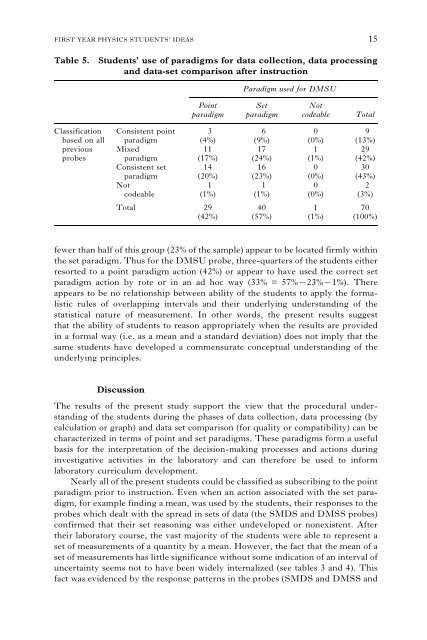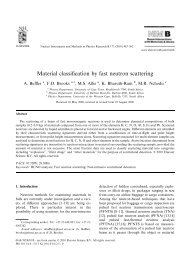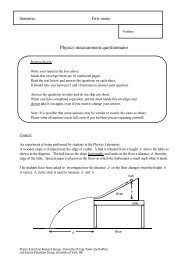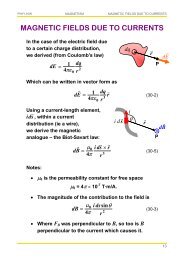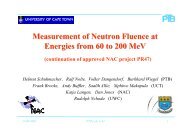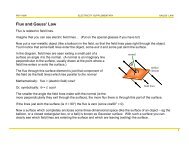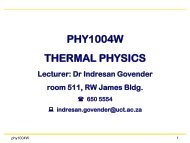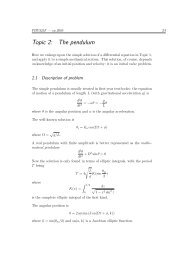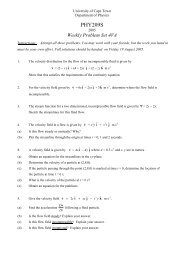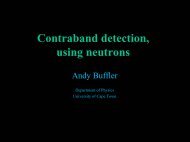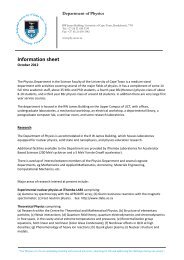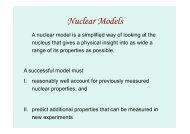ideas about measurement in terms of point and set paradigms
ideas about measurement in terms of point and set paradigms
ideas about measurement in terms of point and set paradigms
You also want an ePaper? Increase the reach of your titles
YUMPU automatically turns print PDFs into web optimized ePapers that Google loves.
FIRST YEAR PHYSICS STUDENTS’ IDEAS 15<br />
Table 5.<br />
Students’ use <strong>of</strong> <strong>paradigms</strong> for data collection, data process<strong>in</strong>g<br />
<strong>and</strong> data-<strong>set</strong> comparison after <strong>in</strong>struction<br />
Paradigm used for DMSU<br />
Po<strong>in</strong>t Set Not<br />
paradigm paradigm codeable Total<br />
Classification Consistent po<strong>in</strong>t 3 6 0 9<br />
based on all paradigm (4%) (9%) (0%) (13%)<br />
previous Mixed 11 17 1 29<br />
probes paradigm (17%) (24%) (1%) (42%)<br />
Consistent <strong>set</strong> 14 16 0 30<br />
paradigm (20%) (23%) (0%) (43%)<br />
Not 1 1 0 2<br />
codeable (1%) (1%) (0%) (3%)<br />
Total 29 40 1 70<br />
(42%) (57%) (1%) (100%)<br />
fewer than half <strong>of</strong> this group (23% <strong>of</strong> the sample) appear to be located firmly with<strong>in</strong><br />
the <strong>set</strong> paradigm. Thus for the DMSU probe, three-quarters <strong>of</strong> the students either<br />
resorted to a po<strong>in</strong>t paradigm action (42%) or appear to have used the correct <strong>set</strong><br />
paradigm action by rote or <strong>in</strong> an ad hoc way (33% = 57%723%71%). There<br />
appears to be no relationship between ability <strong>of</strong> the students to apply the formalistic<br />
rules <strong>of</strong> overlapp<strong>in</strong>g <strong>in</strong>tervals <strong>and</strong> their underly<strong>in</strong>g underst<strong>and</strong><strong>in</strong>g <strong>of</strong> the<br />
statistical nature <strong>of</strong> <strong>measurement</strong>. In other words, the present results suggest<br />
that the ability <strong>of</strong> students to reason appropriately when the results are provided<br />
<strong>in</strong> a formal way (i.e. as a mean <strong>and</strong> a st<strong>and</strong>ard deviation) does not imply that the<br />
same students have developed a commensurate conceptual underst<strong>and</strong><strong>in</strong>g <strong>of</strong> the<br />
underly<strong>in</strong>g pr<strong>in</strong>ciples.<br />
Discussion<br />
The results <strong>of</strong> the present study support the view that the procedural underst<strong>and</strong><strong>in</strong>g<br />
<strong>of</strong> the students dur<strong>in</strong>g the phases <strong>of</strong> data collection, data process<strong>in</strong>g (by<br />
calculation or graph) <strong>and</strong> data <strong>set</strong> comparison (for quality or compatibility) can be<br />
characterized <strong>in</strong> <strong>terms</strong> <strong>of</strong> po<strong>in</strong>t <strong>and</strong> <strong>set</strong> <strong>paradigms</strong>. These <strong>paradigms</strong> form a useful<br />
basis for the <strong>in</strong>terpretation <strong>of</strong> the decision-mak<strong>in</strong>g processes <strong>and</strong> actions dur<strong>in</strong>g<br />
<strong>in</strong>vestigative activities <strong>in</strong> the laboratory <strong>and</strong> can therefore be used to <strong>in</strong>form<br />
laboratory curriculum development.<br />
Nearly all <strong>of</strong> the present students could be classified as subscrib<strong>in</strong>g to the po<strong>in</strong>t<br />
paradigm prior to <strong>in</strong>struction. Even when an action associated with the <strong>set</strong> paradigm,<br />
for example f<strong>in</strong>d<strong>in</strong>g a mean, was used by the students, their responses to the<br />
probes which dealt with the spread <strong>in</strong> <strong>set</strong>s <strong>of</strong> data (the SMDS <strong>and</strong> DMSS probes)<br />
confirmed that their <strong>set</strong> reason<strong>in</strong>g was either undeveloped or nonexistent. After<br />
their laboratory course, the vast majority <strong>of</strong> the students were able to represent a<br />
<strong>set</strong> <strong>of</strong> <strong>measurement</strong>s <strong>of</strong> a quantity by a mean. However, the fact that the mean <strong>of</strong> a<br />
<strong>set</strong> <strong>of</strong> <strong>measurement</strong>s has little significance without some <strong>in</strong>dication <strong>of</strong> an <strong>in</strong>terval <strong>of</strong><br />
uncerta<strong>in</strong>ty seems not to have been widely <strong>in</strong>ternalized (see tables 3 <strong>and</strong> 4). This<br />
fact was evidenced by the response patterns <strong>in</strong> the probes (SMDS <strong>and</strong> DMSS <strong>and</strong>


